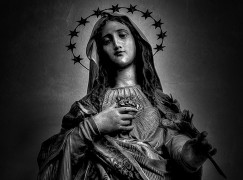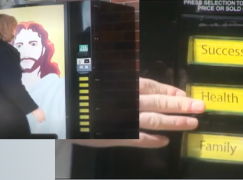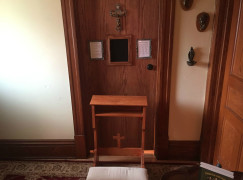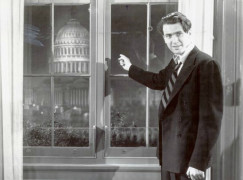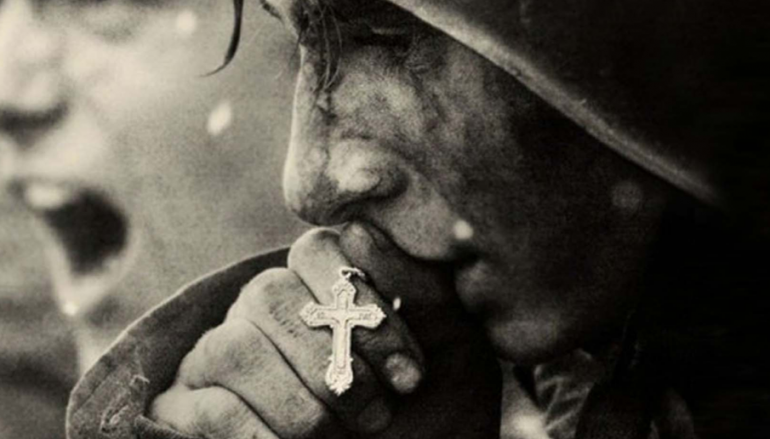

1916 Military Rosary Inspires New Combat Rosary
Men’s faith formation has been a pet project of mine for the last half of my 26 years as a priest. Among many things, I‘ve wanted us men to rediscover the treasury of Catholic devotions. If men are going to be the spiritual leaders of their own domestic church, we simply must explore these time-tested and Church approved jewels of our Catholic life.
As I poured myself into this endeavor, I was struck by how effeminate many of the sacramentals tended to be. It’s no wonder men are inclined to see these devotions as “what women do.” In particular, most of the rosaries looked like women’s jewelry. I began to scour the internet to find something truly masculine in a rosary. Sure, there were the classic black or brown bead rosaries, but they still seemed weak to me.
One day I happened upon a very intriguing rosary among some of the collectors’ websites. It was tough. It was strong. It had a kind of gravitas to it. This was truly a man’s rosary. As I read the description, it turned out I was looking at an original World War I military rosary. As described, it was commissioned and procured by, believe it or not, the U.S. government and issued by the military, upon request, to soldiers serving in World War I. Some of these rosaries were also seen in WWII. The solders usually referred to them as “Service Rosaries.” All of these rosaries were made around 1916. Awesome!!
Now I was really intrigued. I began doing some research on these military rosaries, and I discovered that there were some knock-offs made since the originals in 1916. I wanted to stay clear of those, if I was going to take the dive and purchase an authentic World War I military rosary. So, what made these authentic?
 It turns out that there are certain key elements to the original rosaries. The beads were the kind of beads one sees used for making dog tags. Some call them “lamp pull chain” beads. The government, after trying some prototypes in early production, discovered the best metal for avoiding rust and blacking was a silver washed brass or bronze. While all of the crucifixes are not the same, none of them had company marks on the back (the backs are blank) and they were all silver washed, brass crucifixes. Most of the crucifixes had a swirl or the letters INRI at the end of each cartouche. All of these rosaries measured between 16-17 inches, depending upon the size of the crucifix they used.
It turns out that there are certain key elements to the original rosaries. The beads were the kind of beads one sees used for making dog tags. Some call them “lamp pull chain” beads. The government, after trying some prototypes in early production, discovered the best metal for avoiding rust and blacking was a silver washed brass or bronze. While all of the crucifixes are not the same, none of them had company marks on the back (the backs are blank) and they were all silver washed, brass crucifixes. Most of the crucifixes had a swirl or the letters INRI at the end of each cartouche. All of these rosaries measured between 16-17 inches, depending upon the size of the crucifix they used.
I found it very curious that I would occasionally come across a silver or gold plated rosary among collectors. It turns out that many veterans credited their survival to these rosaries. So, after the war, they went to a jeweler to have them gold-plated or silver-plated.
The most interesting and most identifying feature of these military rosaries was their center medals. The front of the medal always had some image of the Blessed Mother, which was usually Our Lady of Sorrows. But it is the back of this center medal that gives it away as an authentic 1916 World War I military rosary. They all had the same image of Jesus carrying his cross. This symbolized the burdens these soldiers were willing to shoulder for the sake of our freedom.
After deciding upon the authentic military rosary I wanted, and receiving it in the mail, I looked at this “masculine and muscular” military rosary, and said to myself, “The men need to have these!!” However, I wasn’t about to go around paying the high price of the original military rosary. So, on a whim, I called the first pull chain company I found on the internet. I was surprised to hear how receptive they were for making a prototype for the bead portion of this new rosary for men, based on the original 1916 military rosary. A short time later, the prototype arrived in two pieces: The long fifty-bead section, and the short five-bead section to go from center medal to crucifix. It was amazing! It had a lustrous silver glow to it. It was weighty. It was manly!
Now, I was really fired up! I didn’t want to make a replica of the original. I wanted to respect the original that way. Instead, I wanted to make one based on the original, but well suited for the Church Militant to do full-on spiritual warfare. It was time to choose the medals and crucifix.
Of course, the powerful Miraculous Medal was a must for the center medal, but I couldn’t forget about the very powerful “devil-chasing” St. Benedict Medal. One of my favorite features of this powerful medal against evil is the inscription on the back: “Vade retro satana” (“Step back, Satan”). So, I decided these rosaries would have a St. Benedict Medal dangling from the center medal. Also, I decided to offer add-on medals for every branch of the military for soldiers and vets (police and fire medals are offered too).
For the crucifix, the Pardon Crucifix was a must. It is the only crucifix I know that gives indulgences for carrying it or kissing it. These indulgences were declared upon the Pardon Crucifix by Pope St. Pius X in 1905, and were approved in the pardon of the living and the souls in Purgatory in 1907. These medals and crucifix makes this Church Militant Combat Rosary a powerful spiritual assault weapon against evil forces attempting to separate us from the love of God and His will for our lives.
I had a few of these Combat Rosaries made for the men in our apostolate, the Knights of Divine Mercy, but folks started learning about them. There was so much demand that my sister agreed to step in and manage the production and sales of these rosaries. I am so excited that there is a truly masculine Combat Rosary made for men (women really like these too).
Get your Combat Rosary at RomanCatholicGear.com
Original article appeared on OnePeterFive.com




